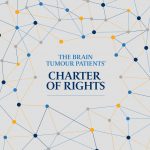Brain cancer and COVID-19 – the mixed messages around the impact of COVID-19 on cancer. How can we protect ourselves?
Sensationalism in the media
‘Virus could mean extra 35,000 deaths from cancer’ The Times, July 2020
‘Friend died too soon when COVID-19 stopped her treatment – leaving son without his mum’ Daily Mail, July 2020
‘Hydroxychloroquine found to significantly reduce mortality in new COVID-19 study’ International Journal of Infectious Diseases, July 2020
‘WHO discontinues hydroxychloroquine and lopinavir/ritonavir treatment arms of Solidarity trial (a COVID-19 study)’ World Health Organisation (WHO), July 2020
Headlines are scary, contradictory and not always objective – they are meant to be this way; it’s called clickbait. Clickbait entices us to follow that link and read, view, or listen to the linked piece of online content, and is often deceptive, typically sensationalised or misleading.
Living with a brain tumour makes us feel alone, vulnerable and scared. Before the diagnosis, you might have dismissed such headlines as irrelevant and nothing to do with you. Now it’s all to easy to absorb and soak up news related to cancer. Where is the truth? What is fact? What is fiction?
Stopping the negative chatter
This is about self-preservation – how can you stop the negative chatter in your head that clickbait brings? Here are two important ways:
-
Appraise and moderate your news intake (particularly where it connects cancer and COVID-19).
We are, as humans, susceptible to doom and gloom in the news. It’s called negativity bias. We take on board the bad news at the expense of the good. This skews our view of the world. Thanks to Facebook, Google and Twitter, news is targeted to specific audiences and the stories that receive the most clicks (often because they are sensationalised) are presented to us constantly. News to the mind is sugar to the body – it’s not healthy. Research tells us that news is a mental health hazard[1].
-
Understand where brain cancer fits in the bigger COVID-19 picture that the press reports.
Yes – it is a catastrophe; in the very early days we could only stick a finger in the wind and guestimate how many more lives would be lost to cancer due to resource being diverted to COVID-19 in an already struggling NHS. Now the scientific data is able to forecast a little more accurately and is putting the figure at 35,000 excess cancer deaths. Even one would be too many.
What we do need to bear in mind is that this spotlight on the catastrophic potential number of avoidable deaths has been about the more common cancers (bowel, breast and lung, for example). How many of the stories in the media have been about these cancers?
Let’s put some perspective on this from the point of view of people with brain cancer. Our experience from daily interactions with the community is that actually, little changed in cases of medical urgency. Where an urgent scan was needed, it was given. If a biopsy was needed because it was thought that the tumour was a high-grade glioma, then this was done, if it was appropriate. This is a broad sweeping statement and we know that there are some of you in the community for whom treatment has been delayed, with consequences that may include heightened anxiety and uncertainty and delays in accessing treatment and care to manage non-life threatening symptoms. This is difficult to tolerate now, and unacceptable in normal times, but in recent weeks and months clinical judgement should have been used to offset this impact against the risk presented by COVID-19.
The problem with brain cancer though, is that it is not like other cancers. For start, there are no screening programmes for brain cancer. Secondly, brain cancer isn’t staged like other cancers. Thirdly, apart from a couple of weeks at the height of the pandemic in April, when surgery for people needing a biopsy slowed due to a lack of anaesthetists (they were on COVID-19 wards) the throughput of patients has been more or less steady. Certainly, the numbers of new people joining our community are pretty much back to pre COVID-19 levels.
Remember the good news
It’s too easy to focus on the negative news you’re hearing, but there is good too:
- New, more effective models of delivering cancer care through cancer hubs have emerged and will be a lasting legacy.
- A focus on increasing radiotherapy services to meet demand through simple, smart and cost-effective changes has delivered a six-point plan.
- Workforce regeneration is being addressed, with the NHS now being an attractive opportunity with increased resourcing.
- Investment in IT systems has enabled remote access for everyone to the healthcare they need. This is an opportunity that is being seen by everyone to transform cancer service delivery, bureaucracy is being swept away, and new models of care that have emerged are providing the footprint that is leading to a coordinated, integrated and adequately resourced NHS.
When in doubt, don’t assume the worst. Ask more questions about the data being presented. And avoid the news!
Our upcoming Thrive webinars will help you to manage the uncertainty, anxiety and stress that living with a brain tumour causes:
Thrive, with an introduction to hypnotherapy (Thursday, 9th July, 3-4.30pm)
Thrive, with the skills to cope with uncertainty (Thursday, 16th July, 3-4.30pm)
[1] Johnstone, WM and Davey GCL. “The psychological impact of negative TV news bulletins: the catastrophising of personal worries’, British Journal of Psychology (13 April 2011).








